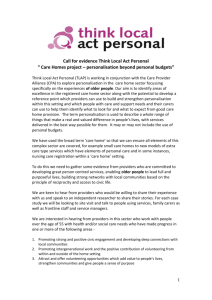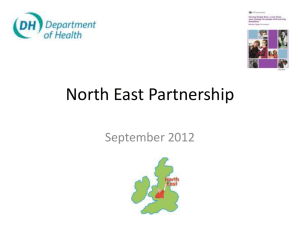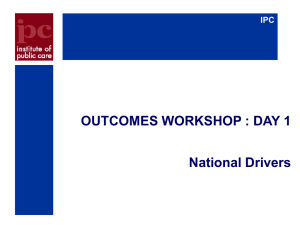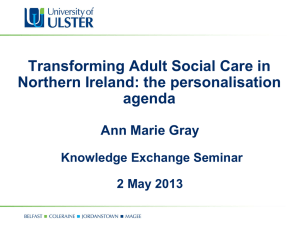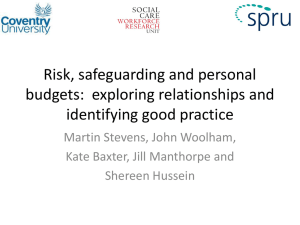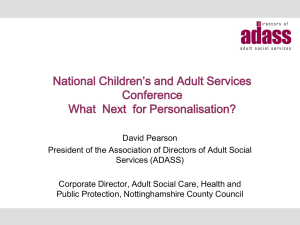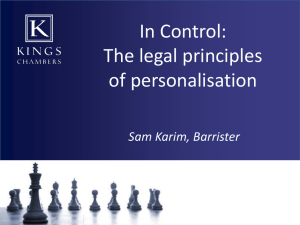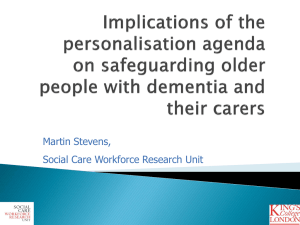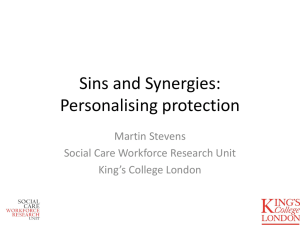WDSAB Annual Conference 4 Jim Leyland
advertisement
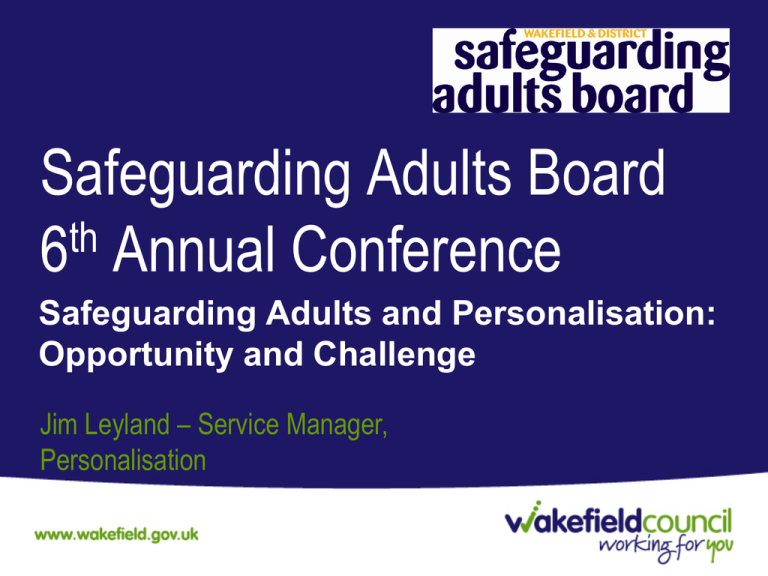
Safeguarding Adults Board th 6 Annual Conference Safeguarding Adults and Personalisation: Opportunity and Challenge Jim Leyland – Service Manager, Personalisation The Challenge • • • • Personalisation – Maximising Choice and Control Rising Demand – Care Bill Reductions in Local Authority finances Ensuring that we are meeting our responsibility to safeguard vulnerable people in our communities. How do you balance these demands and goals? Catch 22 – What are the Barriers to moving forward? • • • • • • • Risk enabling versus Risk Aversion Choice versus Restriction Limited Opportunities versus Real Outcomes Apathy versus Aspiration Control versus Controlled Empower versus Disempower Wise versus Unwise Decisions The Care and Support Bill • • • • Context – Simplicity of the law, focus on Prevention, Information and Market Shaping Core Principles – Citizen Focus, Choice, Control, Fairness and Consistency Culture Shift – Person Centred Care, SelfDetermination and Entitlement to Care and Support Timescales – April 2015 The Care and Support Bill • • • • • • • • • Prevention – Wellbeing, Public Health Committee Safeguarding – Boards, Enquiries Advice and Information - Advocacy and Duty to Provide Paying for Care – Deferred Payments Scheme Charging for Care - Care Cap and Powers of LA Personalisation – Legality, Care & Support Plan Assessment & Eligibility – self funders, carers, assessment Market Shaping – community, asset based Integration – Better Care Fund, health The Care and Support Bill • • • • • • Self Funders – Identifying the Care and Support Needs, currently not being met Carers – Duties to Assess and Provide Safeguarding – Winterbourne, Out of Area Placements Transition – avoiding the ‘cliff edge’ Mental Health Aftercare – Duty to Provide Portability and Ordinary Residence – Improved Customer Offer Making it Real Co-produced approach to agree the three priorities and action plan: • ‘I have the information and support I need in order to remain as independent as possible’ • ‘I have access to a range of support that helps me to live the life I want and remain a contributing member of the community’ • ‘I can decide the kind of support I need and when, where and how to receive it’ Choice and Control • • • • • • • • Diversity and Values Real life Lifestyle Choices Human Rights Mental Capacity Act Risk v Need What is vulnerability? Accountability and Blame Case Scenarios • Article 5 Human Rights Act, 1998 – Right to liberty and security of a person. Example involving a mother who had a learning disability and her son who had a mental health problem • Mental Capacity Act and Deprivation of Liberty Safeguards. Example involving woman self neglecting and disengaging with services. Fundamental Principles • • • • • • Empowerment Prevention Protection Proportionality Partnerships Accountability Personalisation and Safeguarding • • Alert – Respect, Explain, Listen Referral and Decision – Safety needs, share risks, Outcomes, what do I want to achieve? • Strategy discussions – Involvement, Explore options and choices • Assessment and Investigation – Focus on rights and choices • Outcomes – What are my choices? • Monitor and Review – Work collaboratively Making Connections (Isle of Wight), 2011 Shared Responsibility • • • • What does this look like? – Collaboration, creativity, person centred and outcome focused. Informal and formal support – Importance of community based support, informal and formal solutions to meeting need. Engagement – Doing things differently. Confidence and Clarity. Sharing risks – Identify and Manage risks together, do with not to. Good Practice • • • • • • Advice and Information Shared intelligence Prevention and Early Intervention Connect to Support – Balancing choice and risk Personal Assistant Framework – Safeguards and checks Focusing on strengths, expertise and aspiration Maintaining Quality and keeping people safe • • • • • • • Quality Assurance – learning lessons Serious Case Reviews Performance Experience Outcomes Standards of Care Good quality cannot be compromised, despite fiscal and political challenges What needs to happen next? • • • • • • Learning and Development Different way of thinking Working Together and Shared Responsibility Individual Ownership and Responsibility Proportionality Strengths Based The Vision “A ‘good life’ is one that requires a balance between freedom and control.” (Gardner, 2011 – p94) Making informed decisions about needs and risks and promoting independence while protecting people as far as possible from harm and danger. Any Questions ?
